Analyzing Ways of Learning in the Social World: Gender and Class
VerifiedAdded on 2023/01/11
|7
|1907
|72
Essay
AI Summary
This essay delves into the ways individuals learn about the social world, emphasizing the sociological imagination and its influence. It explores the core elements of social class and gender, highlighting how these factors shape individual understanding and interactions within society. The essay discusses gender roles, theories like Positivism and Conflict theory, and the impact of social class divisions on individuals' lives, including the categorization of social classes and their associated characteristics. The conclusion underscores the importance of continuously updating one's knowledge of the social world to navigate societal changes effectively. The essay provides a detailed analysis of how individuals perceive and interact with society, offering valuable insights into sociological concepts and their real-world implications.
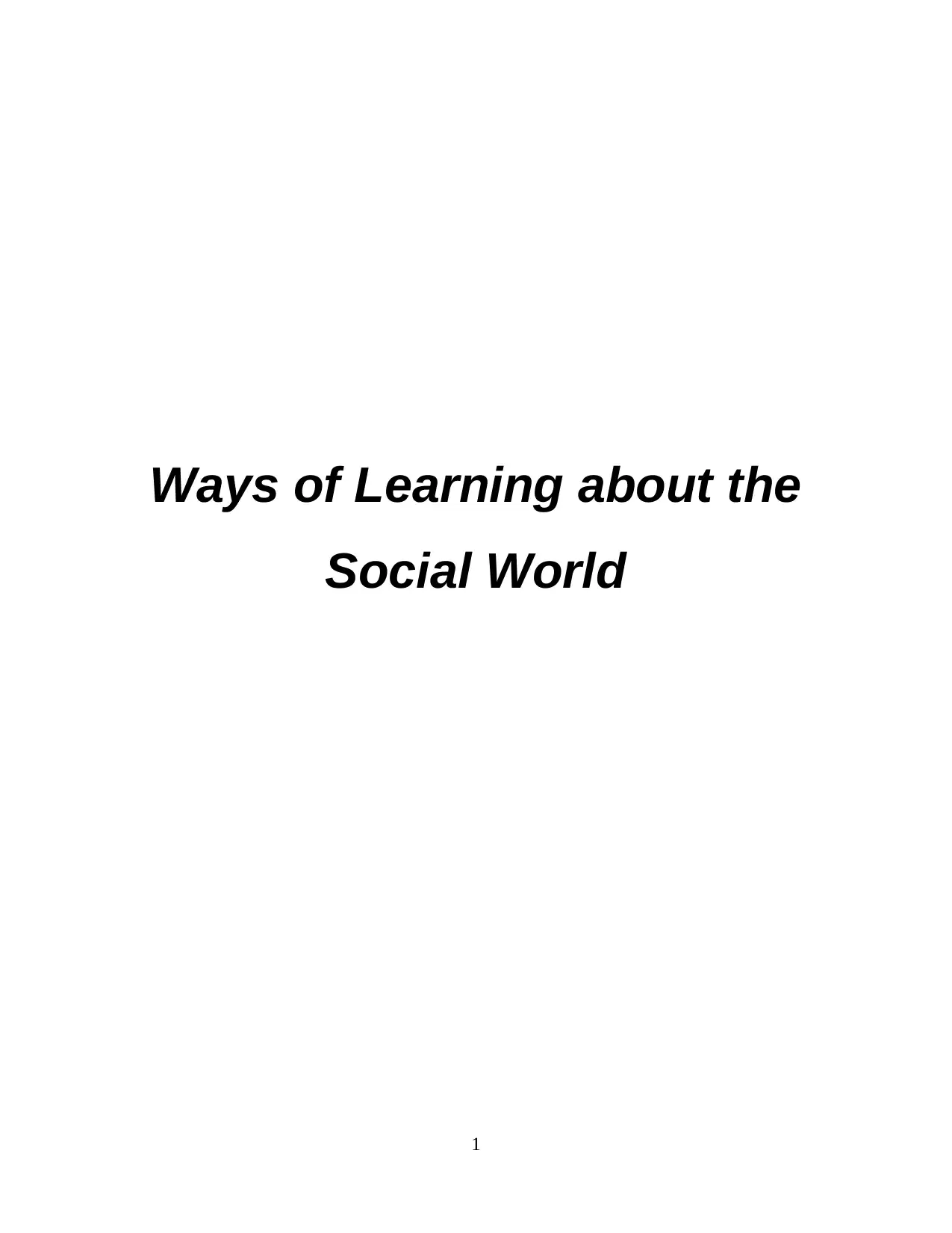
Ways of Learning about the
Social World
1
Social World
1
Paraphrase This Document
Need a fresh take? Get an instant paraphrase of this document with our AI Paraphraser
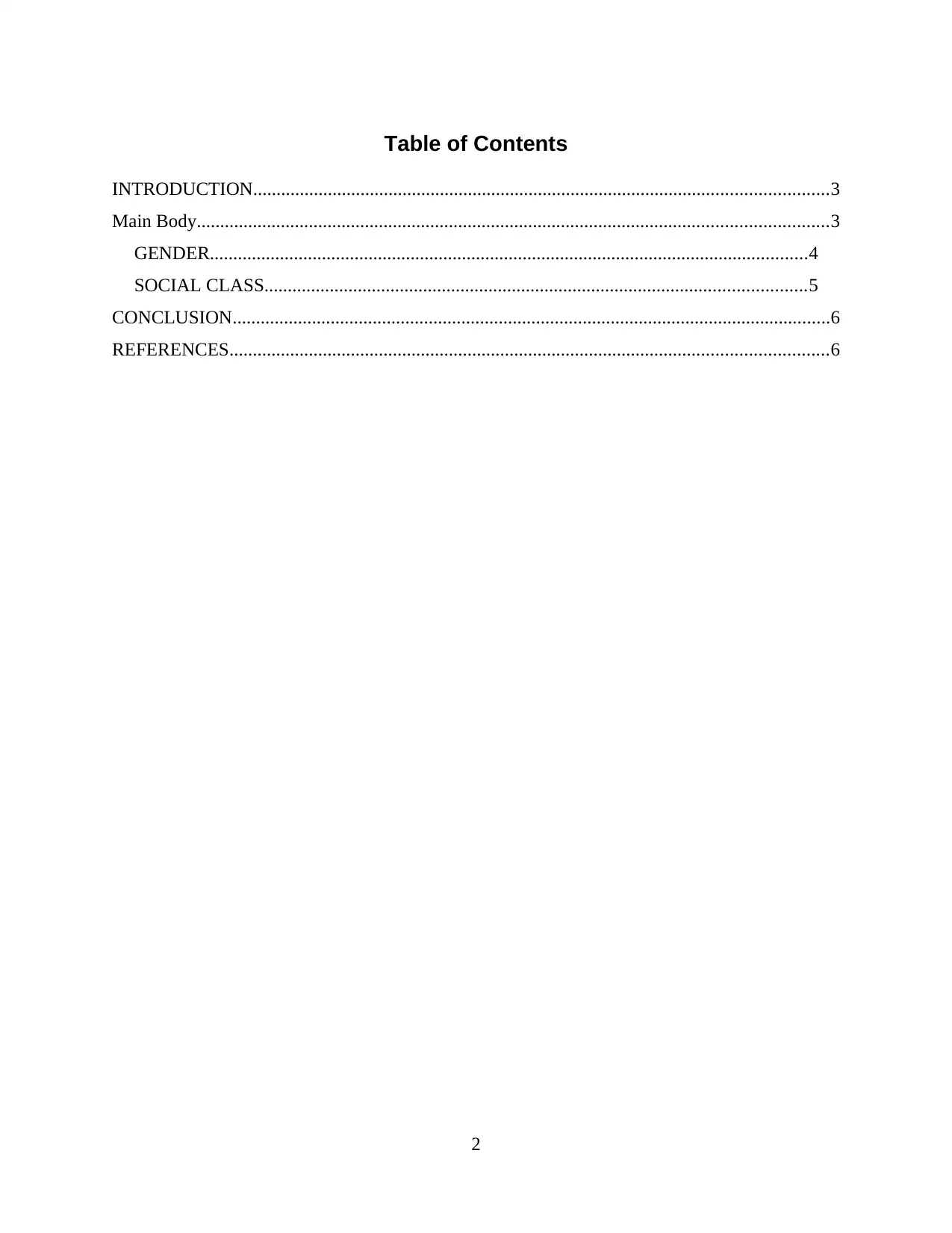
Table of Contents
INTRODUCTION...........................................................................................................................3
Main Body.......................................................................................................................................3
GENDER................................................................................................................................4
SOCIAL CLASS....................................................................................................................5
CONCLUSION................................................................................................................................6
REFERENCES................................................................................................................................6
2
INTRODUCTION...........................................................................................................................3
Main Body.......................................................................................................................................3
GENDER................................................................................................................................4
SOCIAL CLASS....................................................................................................................5
CONCLUSION................................................................................................................................6
REFERENCES................................................................................................................................6
2
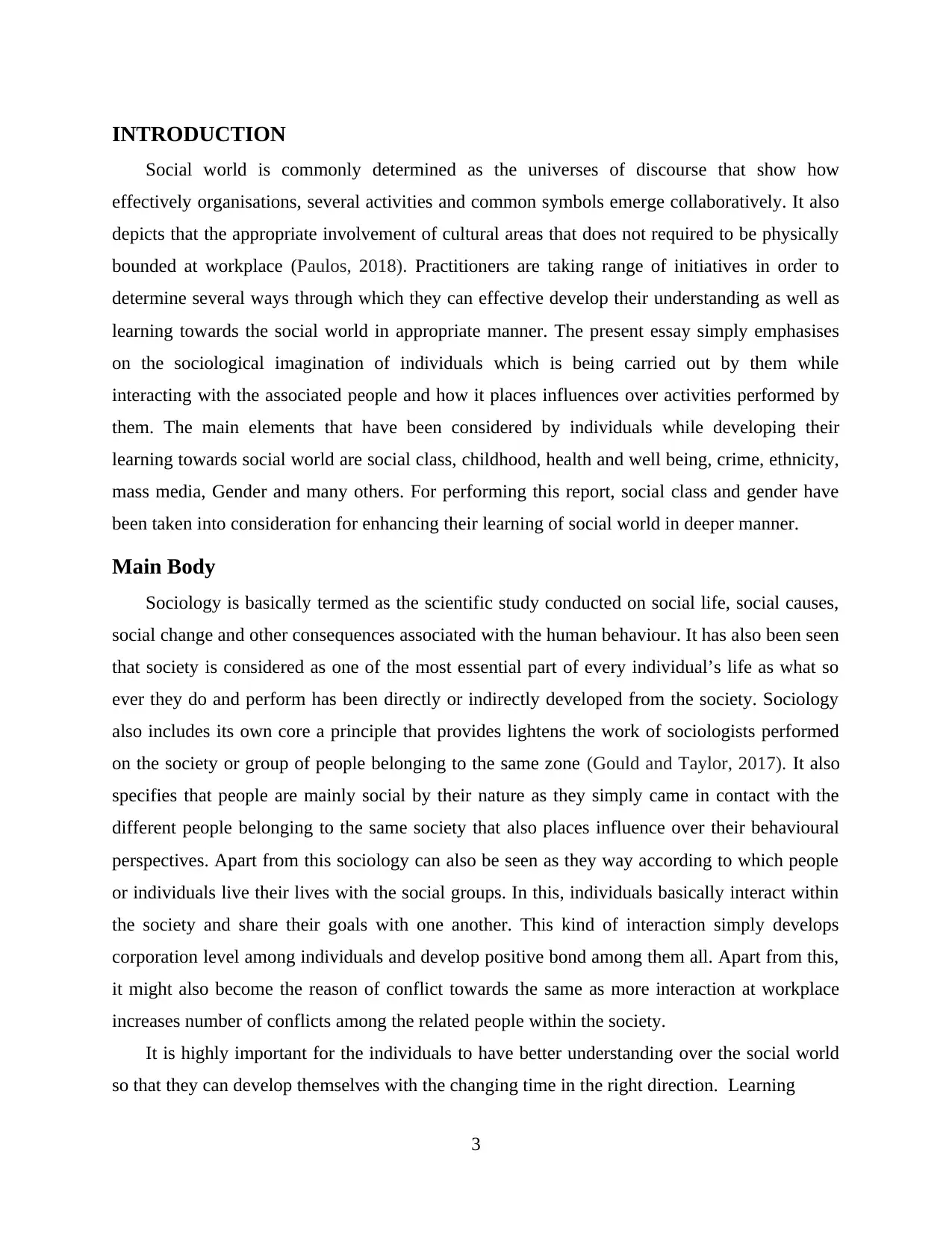
INTRODUCTION
Social world is commonly determined as the universes of discourse that show how
effectively organisations, several activities and common symbols emerge collaboratively. It also
depicts that the appropriate involvement of cultural areas that does not required to be physically
bounded at workplace (Paulos, 2018). Practitioners are taking range of initiatives in order to
determine several ways through which they can effective develop their understanding as well as
learning towards the social world in appropriate manner. The present essay simply emphasises
on the sociological imagination of individuals which is being carried out by them while
interacting with the associated people and how it places influences over activities performed by
them. The main elements that have been considered by individuals while developing their
learning towards social world are social class, childhood, health and well being, crime, ethnicity,
mass media, Gender and many others. For performing this report, social class and gender have
been taken into consideration for enhancing their learning of social world in deeper manner.
Main Body
Sociology is basically termed as the scientific study conducted on social life, social causes,
social change and other consequences associated with the human behaviour. It has also been seen
that society is considered as one of the most essential part of every individual’s life as what so
ever they do and perform has been directly or indirectly developed from the society. Sociology
also includes its own core a principle that provides lightens the work of sociologists performed
on the society or group of people belonging to the same zone (Gould and Taylor, 2017). It also
specifies that people are mainly social by their nature as they simply came in contact with the
different people belonging to the same society that also places influence over their behavioural
perspectives. Apart from this sociology can also be seen as they way according to which people
or individuals live their lives with the social groups. In this, individuals basically interact within
the society and share their goals with one another. This kind of interaction simply develops
corporation level among individuals and develop positive bond among them all. Apart from this,
it might also become the reason of conflict towards the same as more interaction at workplace
increases number of conflicts among the related people within the society.
It is highly important for the individuals to have better understanding over the social world
so that they can develop themselves with the changing time in the right direction. Learning
3
Social world is commonly determined as the universes of discourse that show how
effectively organisations, several activities and common symbols emerge collaboratively. It also
depicts that the appropriate involvement of cultural areas that does not required to be physically
bounded at workplace (Paulos, 2018). Practitioners are taking range of initiatives in order to
determine several ways through which they can effective develop their understanding as well as
learning towards the social world in appropriate manner. The present essay simply emphasises
on the sociological imagination of individuals which is being carried out by them while
interacting with the associated people and how it places influences over activities performed by
them. The main elements that have been considered by individuals while developing their
learning towards social world are social class, childhood, health and well being, crime, ethnicity,
mass media, Gender and many others. For performing this report, social class and gender have
been taken into consideration for enhancing their learning of social world in deeper manner.
Main Body
Sociology is basically termed as the scientific study conducted on social life, social causes,
social change and other consequences associated with the human behaviour. It has also been seen
that society is considered as one of the most essential part of every individual’s life as what so
ever they do and perform has been directly or indirectly developed from the society. Sociology
also includes its own core a principle that provides lightens the work of sociologists performed
on the society or group of people belonging to the same zone (Gould and Taylor, 2017). It also
specifies that people are mainly social by their nature as they simply came in contact with the
different people belonging to the same society that also places influence over their behavioural
perspectives. Apart from this sociology can also be seen as they way according to which people
or individuals live their lives with the social groups. In this, individuals basically interact within
the society and share their goals with one another. This kind of interaction simply develops
corporation level among individuals and develop positive bond among them all. Apart from this,
it might also become the reason of conflict towards the same as more interaction at workplace
increases number of conflicts among the related people within the society.
It is highly important for the individuals to have better understanding over the social world
so that they can develop themselves with the changing time in the right direction. Learning
3
⊘ This is a preview!⊘
Do you want full access?
Subscribe today to unlock all pages.

Trusted by 1+ million students worldwide
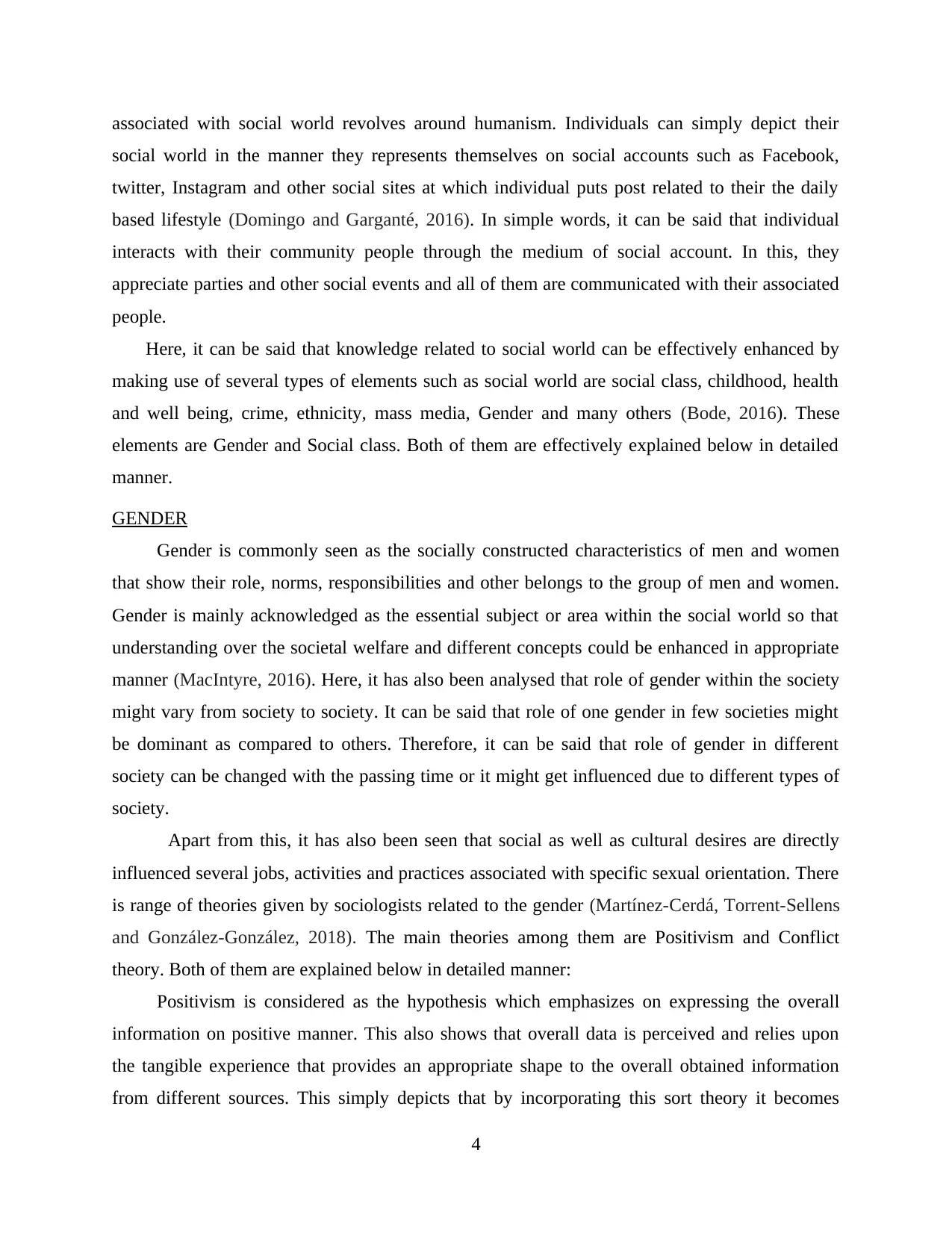
associated with social world revolves around humanism. Individuals can simply depict their
social world in the manner they represents themselves on social accounts such as Facebook,
twitter, Instagram and other social sites at which individual puts post related to their the daily
based lifestyle (Domingo and Garganté, 2016). In simple words, it can be said that individual
interacts with their community people through the medium of social account. In this, they
appreciate parties and other social events and all of them are communicated with their associated
people.
Here, it can be said that knowledge related to social world can be effectively enhanced by
making use of several types of elements such as social world are social class, childhood, health
and well being, crime, ethnicity, mass media, Gender and many others (Bode, 2016). These
elements are Gender and Social class. Both of them are effectively explained below in detailed
manner.
GENDER
Gender is commonly seen as the socially constructed characteristics of men and women
that show their role, norms, responsibilities and other belongs to the group of men and women.
Gender is mainly acknowledged as the essential subject or area within the social world so that
understanding over the societal welfare and different concepts could be enhanced in appropriate
manner (MacIntyre, 2016). Here, it has also been analysed that role of gender within the society
might vary from society to society. It can be said that role of one gender in few societies might
be dominant as compared to others. Therefore, it can be said that role of gender in different
society can be changed with the passing time or it might get influenced due to different types of
society.
Apart from this, it has also been seen that social as well as cultural desires are directly
influenced several jobs, activities and practices associated with specific sexual orientation. There
is range of theories given by sociologists related to the gender (Martínez-Cerdá, Torrent-Sellens
and González-González, 2018). The main theories among them are Positivism and Conflict
theory. Both of them are explained below in detailed manner:
Positivism is considered as the hypothesis which emphasizes on expressing the overall
information on positive manner. This also shows that overall data is perceived and relies upon
the tangible experience that provides an appropriate shape to the overall obtained information
from different sources. This simply depicts that by incorporating this sort theory it becomes
4
social world in the manner they represents themselves on social accounts such as Facebook,
twitter, Instagram and other social sites at which individual puts post related to their the daily
based lifestyle (Domingo and Garganté, 2016). In simple words, it can be said that individual
interacts with their community people through the medium of social account. In this, they
appreciate parties and other social events and all of them are communicated with their associated
people.
Here, it can be said that knowledge related to social world can be effectively enhanced by
making use of several types of elements such as social world are social class, childhood, health
and well being, crime, ethnicity, mass media, Gender and many others (Bode, 2016). These
elements are Gender and Social class. Both of them are effectively explained below in detailed
manner.
GENDER
Gender is commonly seen as the socially constructed characteristics of men and women
that show their role, norms, responsibilities and other belongs to the group of men and women.
Gender is mainly acknowledged as the essential subject or area within the social world so that
understanding over the societal welfare and different concepts could be enhanced in appropriate
manner (MacIntyre, 2016). Here, it has also been analysed that role of gender within the society
might vary from society to society. It can be said that role of one gender in few societies might
be dominant as compared to others. Therefore, it can be said that role of gender in different
society can be changed with the passing time or it might get influenced due to different types of
society.
Apart from this, it has also been seen that social as well as cultural desires are directly
influenced several jobs, activities and practices associated with specific sexual orientation. There
is range of theories given by sociologists related to the gender (Martínez-Cerdá, Torrent-Sellens
and González-González, 2018). The main theories among them are Positivism and Conflict
theory. Both of them are explained below in detailed manner:
Positivism is considered as the hypothesis which emphasizes on expressing the overall
information on positive manner. This also shows that overall data is perceived and relies upon
the tangible experience that provides an appropriate shape to the overall obtained information
from different sources. This simply depicts that by incorporating this sort theory it becomes
4
Paraphrase This Document
Need a fresh take? Get an instant paraphrase of this document with our AI Paraphraser
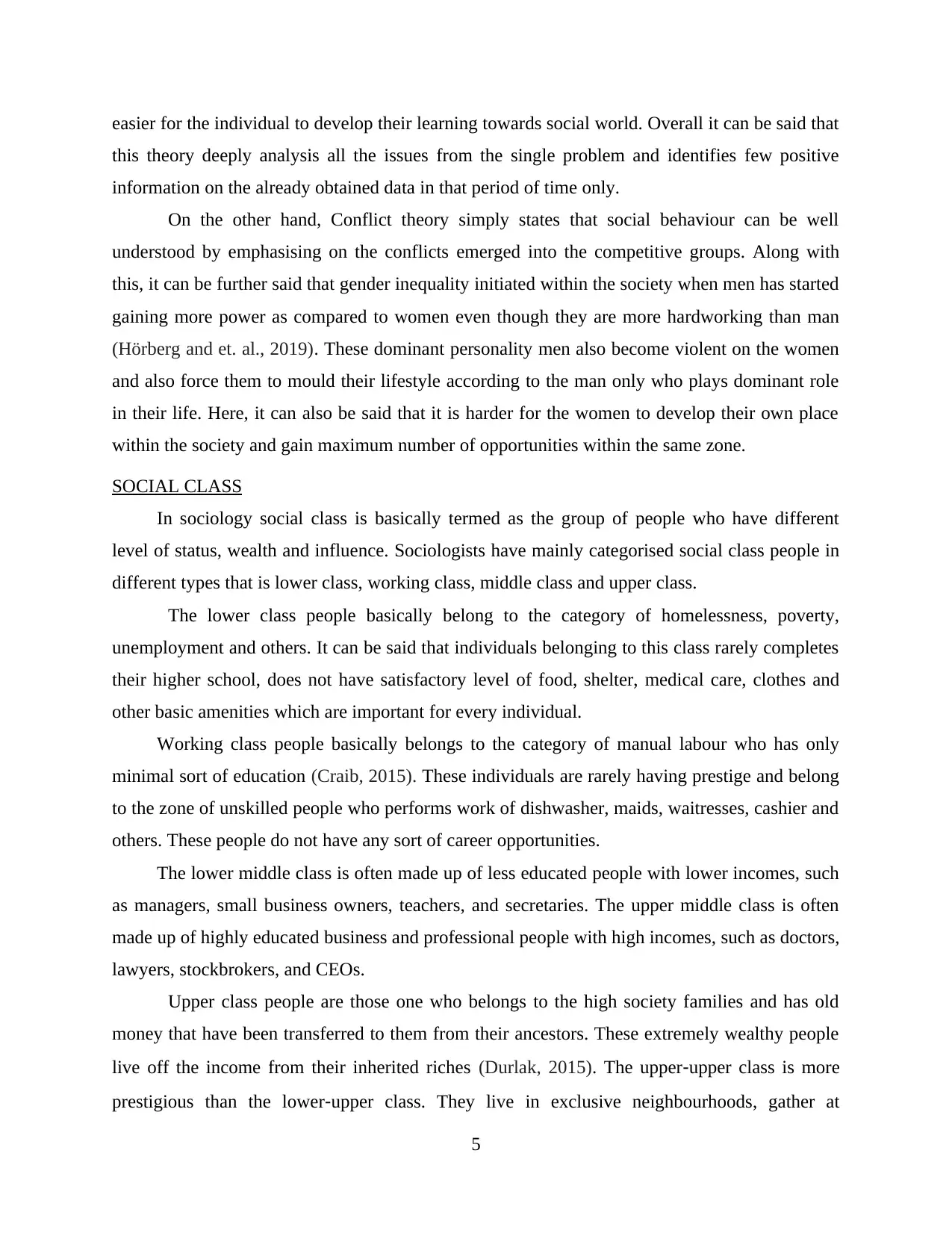
easier for the individual to develop their learning towards social world. Overall it can be said that
this theory deeply analysis all the issues from the single problem and identifies few positive
information on the already obtained data in that period of time only.
On the other hand, Conflict theory simply states that social behaviour can be well
understood by emphasising on the conflicts emerged into the competitive groups. Along with
this, it can be further said that gender inequality initiated within the society when men has started
gaining more power as compared to women even though they are more hardworking than man
(Hörberg and et. al., 2019). These dominant personality men also become violent on the women
and also force them to mould their lifestyle according to the man only who plays dominant role
in their life. Here, it can also be said that it is harder for the women to develop their own place
within the society and gain maximum number of opportunities within the same zone.
SOCIAL CLASS
In sociology social class is basically termed as the group of people who have different
level of status, wealth and influence. Sociologists have mainly categorised social class people in
different types that is lower class, working class, middle class and upper class.
The lower class people basically belong to the category of homelessness, poverty,
unemployment and others. It can be said that individuals belonging to this class rarely completes
their higher school, does not have satisfactory level of food, shelter, medical care, clothes and
other basic amenities which are important for every individual.
Working class people basically belongs to the category of manual labour who has only
minimal sort of education (Craib, 2015). These individuals are rarely having prestige and belong
to the zone of unskilled people who performs work of dishwasher, maids, waitresses, cashier and
others. These people do not have any sort of career opportunities.
The lower middle class is often made up of less educated people with lower incomes, such
as managers, small business owners, teachers, and secretaries. The upper middle class is often
made up of highly educated business and professional people with high incomes, such as doctors,
lawyers, stockbrokers, and CEOs.
Upper class people are those one who belongs to the high society families and has old
money that have been transferred to them from their ancestors. These extremely wealthy people
live off the income from their inherited riches (Durlak, 2015). The upper‐upper class is more
prestigious than the lower‐upper class. They live in exclusive neighbourhoods, gather at
5
this theory deeply analysis all the issues from the single problem and identifies few positive
information on the already obtained data in that period of time only.
On the other hand, Conflict theory simply states that social behaviour can be well
understood by emphasising on the conflicts emerged into the competitive groups. Along with
this, it can be further said that gender inequality initiated within the society when men has started
gaining more power as compared to women even though they are more hardworking than man
(Hörberg and et. al., 2019). These dominant personality men also become violent on the women
and also force them to mould their lifestyle according to the man only who plays dominant role
in their life. Here, it can also be said that it is harder for the women to develop their own place
within the society and gain maximum number of opportunities within the same zone.
SOCIAL CLASS
In sociology social class is basically termed as the group of people who have different
level of status, wealth and influence. Sociologists have mainly categorised social class people in
different types that is lower class, working class, middle class and upper class.
The lower class people basically belong to the category of homelessness, poverty,
unemployment and others. It can be said that individuals belonging to this class rarely completes
their higher school, does not have satisfactory level of food, shelter, medical care, clothes and
other basic amenities which are important for every individual.
Working class people basically belongs to the category of manual labour who has only
minimal sort of education (Craib, 2015). These individuals are rarely having prestige and belong
to the zone of unskilled people who performs work of dishwasher, maids, waitresses, cashier and
others. These people do not have any sort of career opportunities.
The lower middle class is often made up of less educated people with lower incomes, such
as managers, small business owners, teachers, and secretaries. The upper middle class is often
made up of highly educated business and professional people with high incomes, such as doctors,
lawyers, stockbrokers, and CEOs.
Upper class people are those one who belongs to the high society families and has old
money that have been transferred to them from their ancestors. These extremely wealthy people
live off the income from their inherited riches (Durlak, 2015). The upper‐upper class is more
prestigious than the lower‐upper class. They live in exclusive neighbourhoods, gather at
5
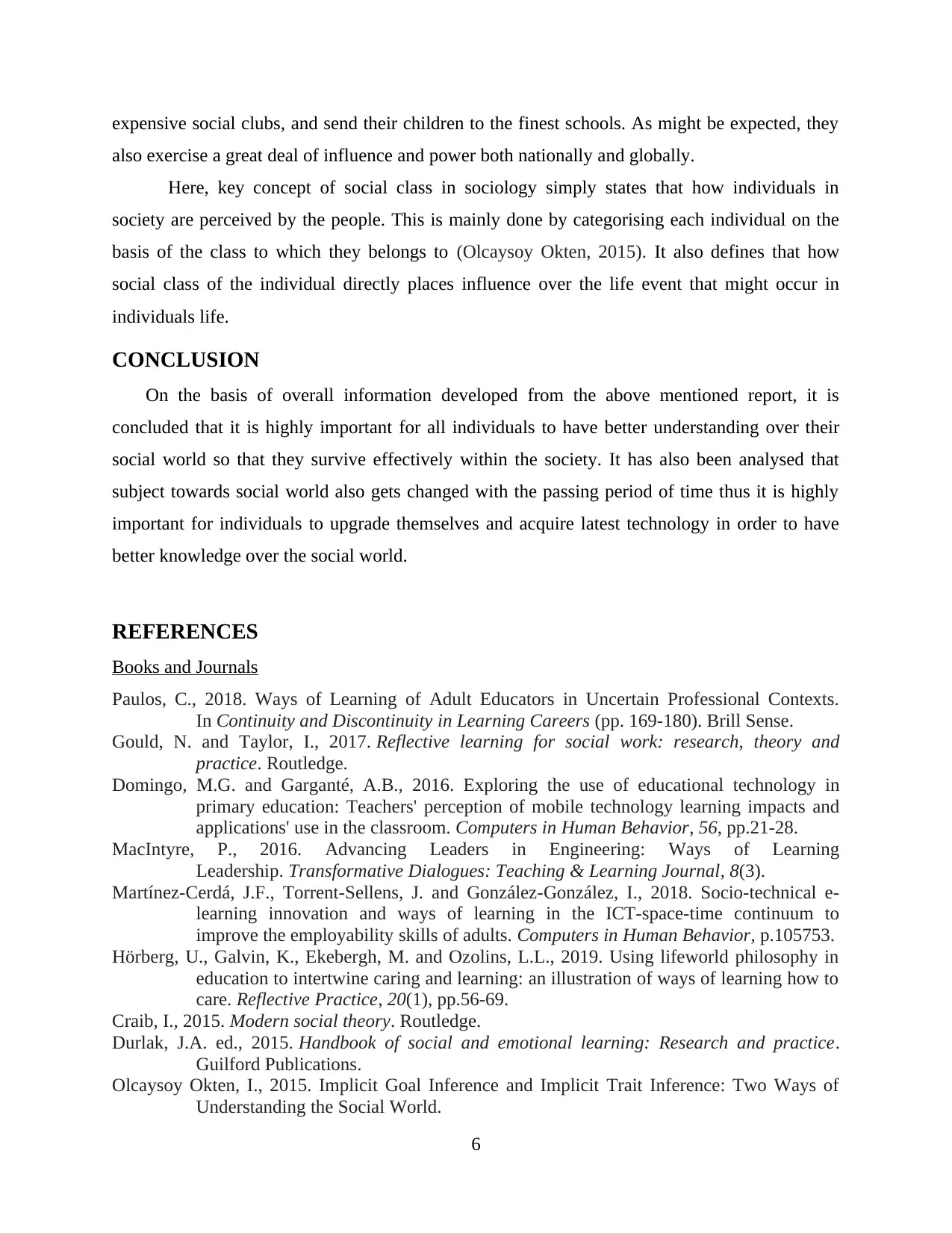
expensive social clubs, and send their children to the finest schools. As might be expected, they
also exercise a great deal of influence and power both nationally and globally.
Here, key concept of social class in sociology simply states that how individuals in
society are perceived by the people. This is mainly done by categorising each individual on the
basis of the class to which they belongs to (Olcaysoy Okten, 2015). It also defines that how
social class of the individual directly places influence over the life event that might occur in
individuals life.
CONCLUSION
On the basis of overall information developed from the above mentioned report, it is
concluded that it is highly important for all individuals to have better understanding over their
social world so that they survive effectively within the society. It has also been analysed that
subject towards social world also gets changed with the passing period of time thus it is highly
important for individuals to upgrade themselves and acquire latest technology in order to have
better knowledge over the social world.
REFERENCES
Books and Journals
Paulos, C., 2018. Ways of Learning of Adult Educators in Uncertain Professional Contexts.
In Continuity and Discontinuity in Learning Careers (pp. 169-180). Brill Sense.
Gould, N. and Taylor, I., 2017. Reflective learning for social work: research, theory and
practice. Routledge.
Domingo, M.G. and Garganté, A.B., 2016. Exploring the use of educational technology in
primary education: Teachers' perception of mobile technology learning impacts and
applications' use in the classroom. Computers in Human Behavior, 56, pp.21-28.
MacIntyre, P., 2016. Advancing Leaders in Engineering: Ways of Learning
Leadership. Transformative Dialogues: Teaching & Learning Journal, 8(3).
Martínez-Cerdá, J.F., Torrent-Sellens, J. and González-González, I., 2018. Socio-technical e-
learning innovation and ways of learning in the ICT-space-time continuum to
improve the employability skills of adults. Computers in Human Behavior, p.105753.
Hörberg, U., Galvin, K., Ekebergh, M. and Ozolins, L.L., 2019. Using lifeworld philosophy in
education to intertwine caring and learning: an illustration of ways of learning how to
care. Reflective Practice, 20(1), pp.56-69.
Craib, I., 2015. Modern social theory. Routledge.
Durlak, J.A. ed., 2015. Handbook of social and emotional learning: Research and practice.
Guilford Publications.
Olcaysoy Okten, I., 2015. Implicit Goal Inference and Implicit Trait Inference: Two Ways of
Understanding the Social World.
6
also exercise a great deal of influence and power both nationally and globally.
Here, key concept of social class in sociology simply states that how individuals in
society are perceived by the people. This is mainly done by categorising each individual on the
basis of the class to which they belongs to (Olcaysoy Okten, 2015). It also defines that how
social class of the individual directly places influence over the life event that might occur in
individuals life.
CONCLUSION
On the basis of overall information developed from the above mentioned report, it is
concluded that it is highly important for all individuals to have better understanding over their
social world so that they survive effectively within the society. It has also been analysed that
subject towards social world also gets changed with the passing period of time thus it is highly
important for individuals to upgrade themselves and acquire latest technology in order to have
better knowledge over the social world.
REFERENCES
Books and Journals
Paulos, C., 2018. Ways of Learning of Adult Educators in Uncertain Professional Contexts.
In Continuity and Discontinuity in Learning Careers (pp. 169-180). Brill Sense.
Gould, N. and Taylor, I., 2017. Reflective learning for social work: research, theory and
practice. Routledge.
Domingo, M.G. and Garganté, A.B., 2016. Exploring the use of educational technology in
primary education: Teachers' perception of mobile technology learning impacts and
applications' use in the classroom. Computers in Human Behavior, 56, pp.21-28.
MacIntyre, P., 2016. Advancing Leaders in Engineering: Ways of Learning
Leadership. Transformative Dialogues: Teaching & Learning Journal, 8(3).
Martínez-Cerdá, J.F., Torrent-Sellens, J. and González-González, I., 2018. Socio-technical e-
learning innovation and ways of learning in the ICT-space-time continuum to
improve the employability skills of adults. Computers in Human Behavior, p.105753.
Hörberg, U., Galvin, K., Ekebergh, M. and Ozolins, L.L., 2019. Using lifeworld philosophy in
education to intertwine caring and learning: an illustration of ways of learning how to
care. Reflective Practice, 20(1), pp.56-69.
Craib, I., 2015. Modern social theory. Routledge.
Durlak, J.A. ed., 2015. Handbook of social and emotional learning: Research and practice.
Guilford Publications.
Olcaysoy Okten, I., 2015. Implicit Goal Inference and Implicit Trait Inference: Two Ways of
Understanding the Social World.
6
⊘ This is a preview!⊘
Do you want full access?
Subscribe today to unlock all pages.

Trusted by 1+ million students worldwide
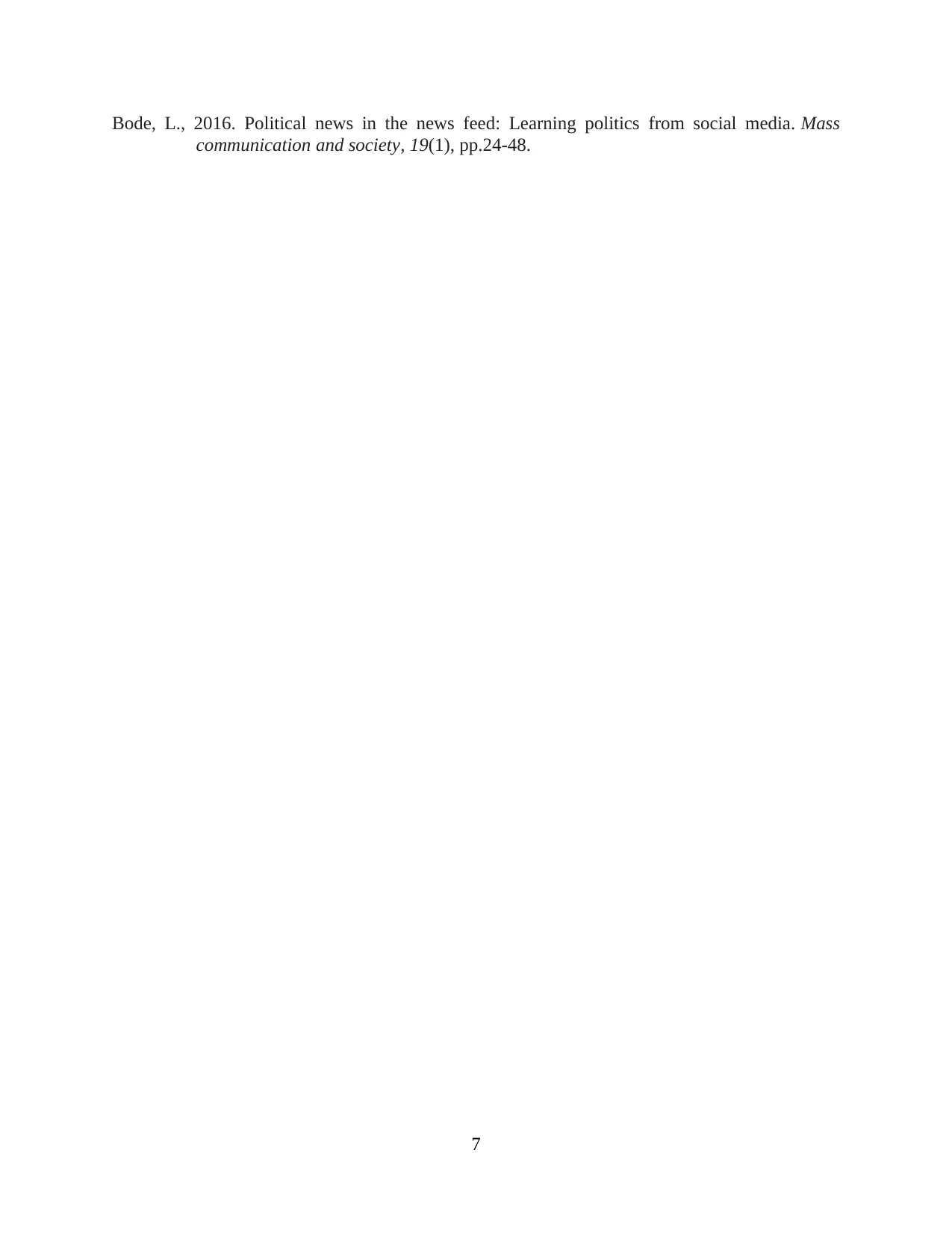
Bode, L., 2016. Political news in the news feed: Learning politics from social media. Mass
communication and society, 19(1), pp.24-48.
7
communication and society, 19(1), pp.24-48.
7
1 out of 7
Related Documents
Your All-in-One AI-Powered Toolkit for Academic Success.
+13062052269
info@desklib.com
Available 24*7 on WhatsApp / Email
![[object Object]](/_next/static/media/star-bottom.7253800d.svg)
Unlock your academic potential
Copyright © 2020–2025 A2Z Services. All Rights Reserved. Developed and managed by ZUCOL.





